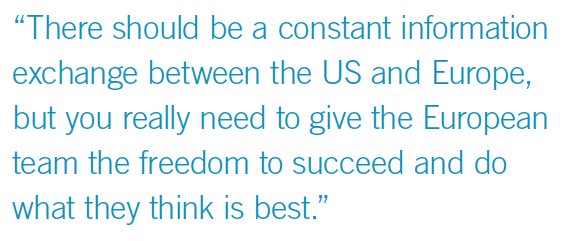The Route to Market Access in Europe
Exploring the roadmap for US-based, R&D-focused biopharma companies seeking to successfully penetrate product markets and reach patients in Europe.
Key considerations for emerging biopharmas seeking to tap region
After the US, Europe is the world’s biggest pharma market, but the region is “significantly more challenging than the US in terms of entering the market and accessing patients,” according to a new report. Seven Secret Ingredients for Successfully Launching and Commercializing a Biopharma’s First Drug in Europe, by Christian Schuler, senior partner, and Lukas Hirn, senior consultant, respectively, at Simon-Kucher & Partners, notes that while “transitioning from an R&D-focused biopharma company to a commercially viable operation is already a challenging endeavor, the prospect of having to master complex European launch requirements while also steering US business makes this shift even more daunting.” This is particularly the case for companies without any regional presence or experience.
Faced with the complexities of navigating the pricing and market access landscapes of 28 different European Union member states, most emerging biopharma companies take the “easier” option and out-license or partner with other companies, primarily big pharma. But this strategy, the authors warn, “may leave significant shareholder value, learning, and scaling opportunities on the table.”
In highlighting that many emerging US-based, R&D-focused biopharma companies are failing to grasp the importance of the factors needed for successful access to the European markets, the report-which is drawn from research covering “more than 20 company analog cases, 4,500 data points, and 18 industry expert
Christian Schuler

discussions”-raises a number of pertinent questions. Pharm Exec caught up with Schuler to address those questions and to distill the report’s findings and recommendations for preparing and executing a successful launch in Europe.
“If we want to boil things down to the key mistake that companies make, it’s not having the right product with the necessary clinical evidence to really substantiate the clinical value of the product,” explains Schuler. “This means there’s a mismatch between the company’s opinion of the value of a drug and what is perceived by the European payers.” In a lot of therapeutic areas in the US, prices can be twice, three times, even four times the price of those drugs in Europe. This leads companies to be “over-aspirational,” he adds. “They think they can achieve a similar price in Europe. But then the product does not live up to its promises.” The wrong pricing strategy leads to lower revenues than originally planned for, and for a one-product company this negatively impacts the organizational setup.
Another mistake is that a company often fails to engage with the key medical and payer stakeholders early on. “Executives need to broaden their outlook regarding the commercial attractiveness of their drug in worldwide markets, ideally at the very beginning of the process or, at the latest, prior to setting up pivotal clinical trials,” Schuler told Pharm Exec. “There needs to be some payer-rationalized clinical trial design research, where you ask, ‘How should we set up this trial in order to optimally meet your needs and deliver the value that you want to see?’” Best practice is to break up silos and identify assumptions to engage early on with regional regulatory bodies (e.g., EMA) and country-specific payer authorities (such as NICE in the UK, the Transparency Commission in France, and the Federal Joint Committee [G-BA] in Germany) to understand key requirements for the ideal clinical trial design and successful approaches to pricing and market access.
All of this takes time, of course. For Schuler, companies should start their planning well ahead of their European launch. This involves setting in place the general manager, the CEO of the European organization, and “a small core team around” the European CEO (covering clinical, medical, pricing and market access, and commercial), all of whom should be hired “ideally two years before the launch,” says Schuler. “The quality of the people that you are selecting here is key. They must be very open and prepared to communicate

interactively, and to cooperate very closely with the other functions.”
Just thinking that a company can transfer what it has done in the US to Europe is “definitely not the right way to go,” explains Schuler. “The secret ingredient is to hire the right talent and to empower them in the best possible way. You need European experts. There should be a constant information exchange between the US and Europe, but you really need to give the European team the freedom to succeed and do what they think is best given the product, its merits, and the knowledge of the European healthcare market.”
Breaking down the markets
With the initial core talent in place, companies should then plan how they will approach the individual markets in Europe. Germany and the UK are “normally markets where products can be launched first,” says Schuler. In France, Italy, and Spain, affiliate offices should be established about a year before launch. “In those countries, it very much depends on how good you are at bringing the product to market fast, and on your negotiation skills with the respective health authorities,” he says. “But you will need to be a little flexible. In Italy or Spain, for example, time to market can take longer than expected-sometimes two, three, even four years. So, you won’t need to hire the full affiliate team right from the start, maybe just the general manager and a pricing and market access expert for that market. You can start hiring the rest of the commercial team about six months before launch.”
The UK and German markets are not without their own challenges, of course. Traditionally, these markets were free pricing markets. But in the UK, a lot of patient access schemes require significant discounts in order to make a product “cost effective.” Germany offers free pricing for the first year, but since the introduction of the AMNOG law in 2011, this has required a benefit assessment of every new drug by the G-BA, which looks at the value of a product based on its clinical merits for six months. Based on these issues, the benefit assessment follows a rating scale from “no added benefit” to “major clinical benefit.” Subsequent price negotiations between the pharma company and the National Association of Statutory Health Insurance Funds (GKV-SV) then take another six months, until a negotiated price between both parties finally is agreed on. If no agreement on the price is reached after this process, an arbitration board issues a verdict on the final price three months later (i.e., 15 months after a product’s launch).
Formulating the strategy for the UK, Germany, France, Spain, and Italy is one thing, but it potentially leaves another 23 countries to think about. How does a company tailor its model when expanding farther into Europe? For Schuler, “it definitely depends on the product that you have, and often on the prevalence of the disease. Where are the patients? Where are the buckets of patients? For diseases related to genetic defects, you may find ‘hot spots’ for patients in parts of the Nordics or Portugal, for example.”
For access to Eastern Europe, Schuler found that companies either establish a hub in Austria or Poland or out-license or partner with other companies for those markets. While it “normally takes much longer to get access to those markets, the opportunity might not be that large to justify the setup of one’s own commercialization infrastructure,” he adds.
Going it alone
Faced with the variables and the complexities of the European markets, an emerging biopharma company could be forgiven for thinking that it is better to take the out-licensing or partnering route. Indeed, Schuler says the experts canvassed for the report agree that it is “probably not worth” going it alone for just one product. In that situation, a company should think about out-licensing or partnering unless there are additional indications for the product being launched, or the company has other promising products in its R&D pipeline.
But Schuler notes that “quite a number of successful companies have done it on their own.” He explains: “There are significant financial upsides if you have the right drug, which offers a high degree of therapeutic improvement in an area of very high unmet medical need, or you have a smaller patient population (e.g., orphan or ultra-orphan disease areas) that does not require you to have a significant organizational setup.” If the value of a product is acknowledged by the payers “because there is nothing else out there,” and the company is able to achieve a good or high price for it, then they are on the road to success.
It is then a case of building the commercial organization or the commercial setup around the drug that fits the needs of the drug, “so it’s not just copy-and-pasting what others might have done,” says Schuler. With that in mind, a product “can easily make $200 million or $400 million, or even well beyond that,” he adds, and the company is in “a good position to become the next Celgene, Biogen, or BioMarin.”
Julian Upton is Pharm Exec’s Online and European Editor. He can be reached at jupton@mmhgroup.com

Trump: 'Major Tariff' on Pharmaceuticals Coming Soon
Published: April 9th 2025 | Updated: April 9th 2025“We’re going to tariff our pharmaceuticals, and once we do that, they are going to come rushing back into our country," President Donald J. Trump said during a Tuesday night dinner in Washington.